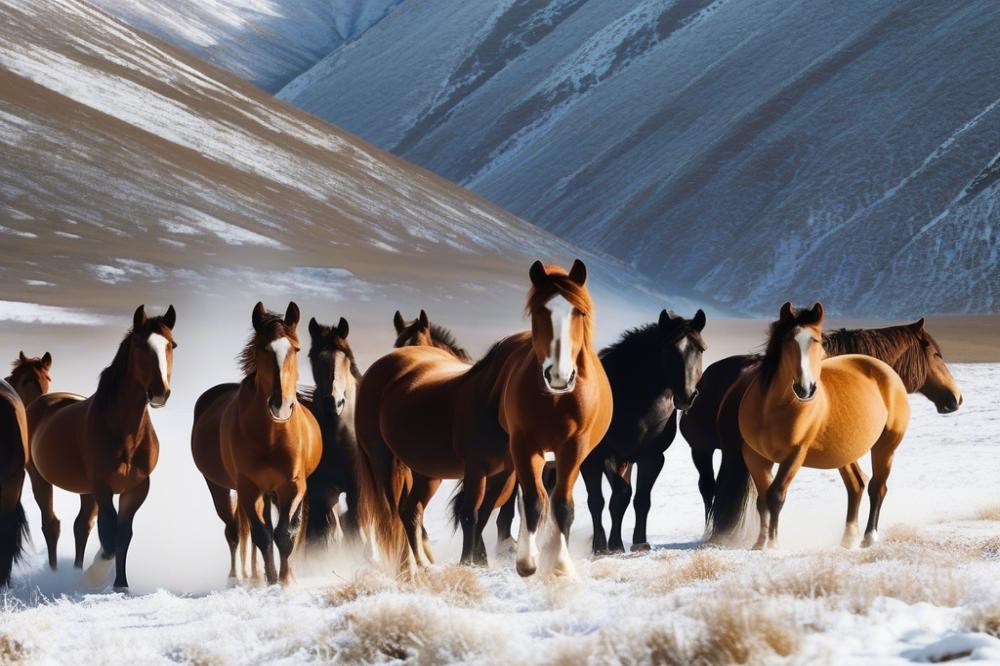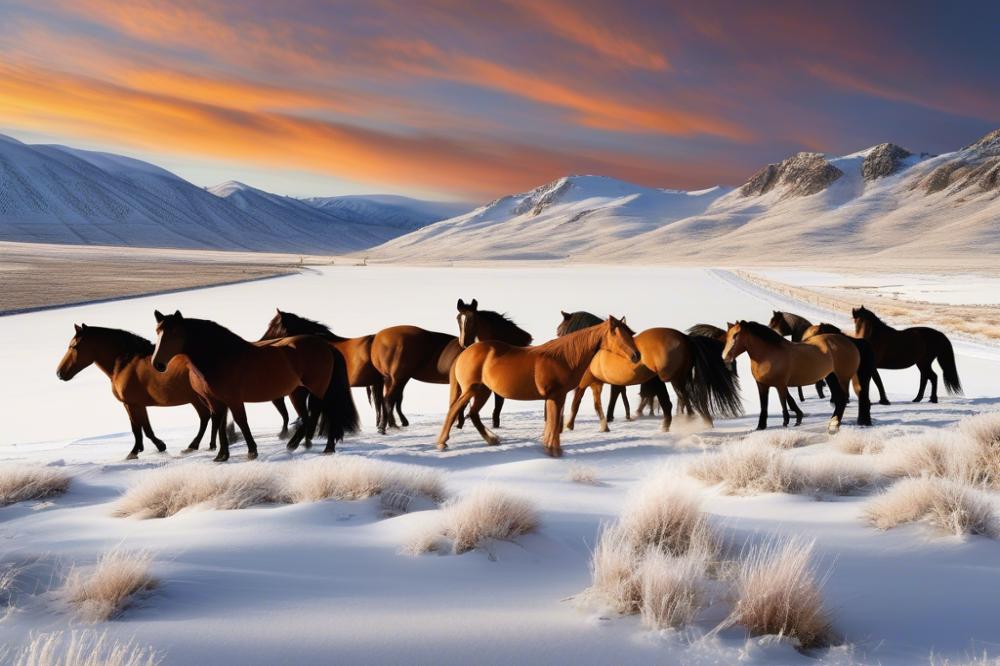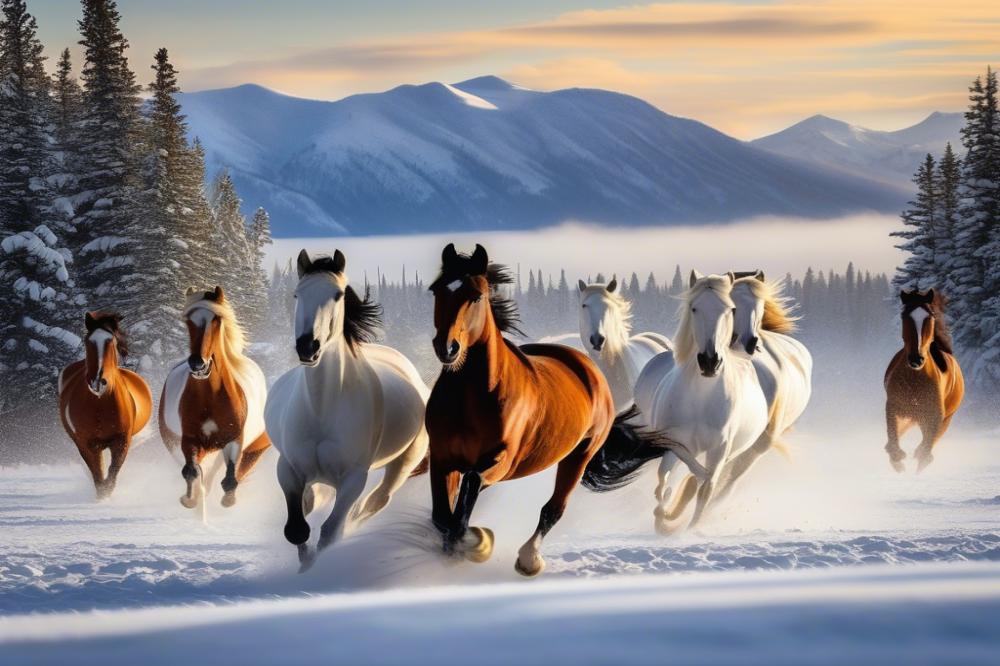The Snowy Valleys of Canada: Home to Majestic Wild Horse Herds
The world of Wild Horses has always captivated human imagination and admiration. These magnificent animals symbolize freedom and resilience. Their presence in an ecosystem plays an important role. Not only do they influence vegetation growth, but they also contribute to the overall health of their habitat. Grazing patterns shaped by these animals promote biodiversity, supporting various species that thrive in the same environment.
Across the globe, feral horses have created a unique narrative. In some parts of the world, they run freely as symbols of wildness. Other regions have viewed them as pests, which creates fierce debates about their existence. In places like the American West, these herds have sparked concern and controversies. Their populations are managed through various methods, with each approach having its staunch supporters and critics. The lives of these horses reflect both wilderness and the impact of human activity.
In Canada, there lies the Snowy Valleys, where these majestic creatures make their home. This stunning habitat offers a blend of high mountain terrain and vast plateaus. Snow-capped peaks provide a breathtaking backdrop, making it an ideal setting for Wild Horses. These gentle giants roam the valleys, bringing a sense of wonder to those lucky enough to witness their grace. Here, they interact with the harsh elements of nature, adapting to the challenges of their environment. Their survival in such a rugged landscape showcases their strength and beauty.
The Wild Horses of Canada

Canada hosts diverse herds of wild horses. These majestic creatures roam freely across expansive landscapes. Found primarily in Alberta and British Columbia, they represent a unique part of the country’s natural heritage. Their existence is not just a sight to see; it’s a living link to the history of the land and its people.
Description of Canada’s Wild Horse Herds
In the Snowy Valleys, these horses thrive in the rugged terrain. They adapt well to changing seasons, often moving to find food and water. Herds can vary significantly in size, ranging from a few individuals to dozens. Their social structures are fascinating; mares often lead the way, while stallions protect the group. Observing them in their natural habitat offers a glimpse into their day-to-day lives, showcasing their intelligence and emotional connections.
The Breeds and Characteristics of the Equine Population
Various breeds can be found among the herds. Mustangs are the most recognizable, known for their resilience and strength. The Spanish Barb and the Kiger Mustang also contribute to the genetic diversity seen in these groups. Many have a rugged physique, often displaying a range of colors and patterns. Their manes and tails can be thick and flowing, enhancing their beauty as they gallop through the valleys.
Historical Significance and Cultural Aspects of Wild Horses in Canada
Wild horses have deep historical roots in Canadian culture. They were once used by Indigenous peoples for transportation and hunting. Horses symbolize freedom and spirit, often appearing in stories and art. The presence of these animals reminds us of a time when they roamed freely across vast territories. Today, they represent a vital aspect of Canada’s natural heritage and an important connection to its past.
Natural Habitat and Breathtaking Landscapes

The snowy valleys of Canada present a strikingly beautiful environment. Tall mountains rise majestically into the sky, creating a perfect backdrop for the wild horses. Deep valleys cradle lush meadows that thrive even in harsh winters. These areas are rich in biodiversity, housing various plants and animals. Unique features of the terrain, like frozen rivers and thick forests, add to the allure.
This habitat plays a crucial role in the survival of the horse herds. Adequate space allows them to roam freely and find food. Natural shelters from harsh weather conditions protect them from the elements. Meadows provide vital grazing ground, essential for their nutrition. The mix of snow, grass, and vegetation supports their diet, helping them remain strong and healthy.
The landscape influences horse behavior significantly. The open spaces encourage social interactions among herd members. Dominance hierarchies develop based on size and strength, crucial for group cohesion. In areas with dense forest, however, horses may become more cautious. They adapt their movements to avoid potential dangers, showing their intelligence and resilience.
Effects of the terrain can also be observed in herd dynamics. Groups tend to stay together in vast fields, but may separate in rougher terrain. These separations can lead to new social bonds forming. Relationships within the group shift as members take on different roles. It’s fascinating to see how these majestic animals navigate their environments.
Challenges Facing Wild Horse Populations
Wild horse populations in Canada face many challenges. Habitat loss is a significant threat. As cities expand and agriculture grows, their natural environments shrink. This diminishes the space these animals need to thrive. It also restricts their access to food and water. Without enough room, herds may struggle to survive.
Climate change poses another challenge. Rising temperatures and altered weather patterns affect the landscape. Droughts can reduce the availability of grasslands. Harsh winters may also become more severe, impacting their health. These environmental shifts create hardships for an already vulnerable species.
Human interaction complicates the situation further. Increasing tourism puts pressure on their habitats. While people enjoy observing these animals, disturbances can lead to stress. Some individuals may even attempt to approach or feed the horses, disrupting their natural behaviors. Unfamiliar noises can cause fear and anxiety, making it harder for horses to remain wild and free.
Efforts are underway to protect these magnificent creatures. Conservation groups monitor wild horse herds and advocate for their needs. They work on creating protected areas to prevent habitat loss. Education about the importance of wild horses can inspire people to support protection measures. Awareness campaigns aim to highlight the threats these animals face. Engaging the public in conservation can foster a deeper appreciation for their role in the ecosystem.
Policies are being developed to balance human activities and horse populations. Local governments are beginning to recognize the significance of these herds to Canada’s natural heritage. Support from communities is essential to ensure the future of wild horses in the snowy valleys. Without collective action, these unique animals could face further decline.
Wildlife and Tourism in the Snowy Valleys
Role of Wild Horses in wildlife Tourism
Wild horses have become a symbol of beauty in the Snowy Valleys. Many tourists come specifically to see these majestic animals in their natural habitat. Their presence attracts not only animal lovers but also photographers and nature enthusiasts. Tour guides often highlight the horses’ historical significance and their role in local ecosystems. This unique aspect of wildlife tourism creates unforgettable memories for visitors.
Economic Benefits and Promoting Conservation Through Tourism
Tourism centered around the valleys boosts the local economy significantly. Small towns depend on travelers for income, creating jobs in hospitality and transportation. Tourists are willing to pay for guided tours, accommodations, and merchandise. Funds generated from wildlife tourism can be reinvested into conservation efforts. Protecting the natural environment ensures that future generations can enjoy the beauty of the valleys as well.
Experiences and Activities for Visitors to the Snowy Valleys
Visitors can engage in various activities while exploring the valleys. Horseback riding offers a close encounter with the landscape. Hiking trails wind through stunning vistas, providing opportunities for observation and photography. Wildlife watching tours allow guests to see different species, including the wild horses. Local events, such as photography workshops, enhance the experience even more. Many visitors leave with a deeper appreciation for nature and wildlife conservation.
Conservation Strategies and Future of Wild Horses
Current conservation initiatives in Canada
Many organizations focus on protecting the herds in the snowy valleys. They implement various strategies to help maintain and grow the populations. Gathering data about the horses is essential. This information assists in understanding their movements and health. Monitoring these creatures often involves local wildlife experts and volunteers. Together, they form a network dedicated to the horses’ survival. In some regions, the government collaborates with non-profits to create safe habitats. Protection laws are enforced to prevent poaching and reduce habitat destruction.
The role of local communities and organizations in safeguarding horse herds
Local communities play a vital role. Residents often engage in conservation efforts, raising awareness about the horses’ plight. Workshops and educational programs inform people about the benefits of preserving these animals. Many groups also organize clean-up events in key habitats. By removing trash and human debris, they create healthier environments. Partnerships between locals and environmental organizations can yield positive results. Community support is crucial for successful conservation initiatives.
Future outlook for wild horse populations and the importance of sustained conservation efforts
The future of these equine populations looks hopeful, but challenges remain. Growing human populations encroach on their habitats. Climate change also impacts food sources and migration patterns. Ongoing conservation strategies are essential for counteracting these threats. If efforts continue, some experts believe the numbers could stabilize. However, this requires commitment from all parties involved. Advocacy for policy changes may help secure better protections. Continuous education will empower communities to take action. Ultimately, a collaborative approach is key to ensuring their legacy in Canada.
Final Thoughts
The wild horses of Canada’s snowy valleys hold a significant place in our natural heritage. These remarkable creatures are not just a sight to behold but also symbolize the spirit of untamed wilderness. Their presence in the icy landscapes illustrates the connection between wildlife and the ecosystems they inhabit. As we witness their majesty, we must also recognize the threats they face. Habitat loss, climate change, and human encroachment endanger their existence.
Protecting these majestic animals should be a priority for all. Communities, policymakers, and conservation groups must collaborate. Efforts should focus on preserving their natural habitat and promoting coexistence with humans. Everyone can play a role in protecting these populations, from raising awareness to supporting local conservation initiatives.
Wild horses are not isolated beings; they are part of a larger web of life. Reflecting on their significance highlights the importance of conservation efforts. Protecting their habitat helps ensure a balanced ecosystem, benefiting all species that call this region home. In embracing our role as stewards of the land, we recognize the interconnectedness of all living things. Let’s stand together to safeguard the majestic wild horses and the snowy valleys that nurture them.



